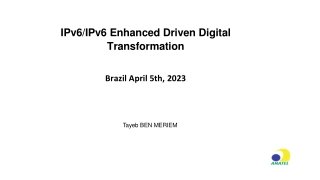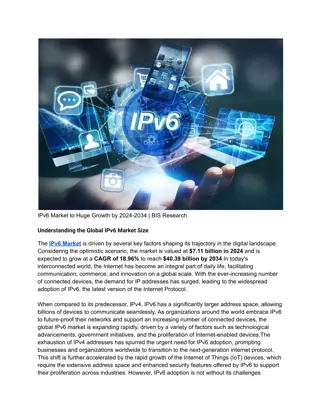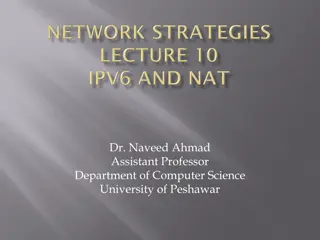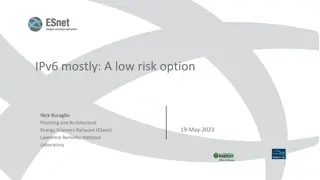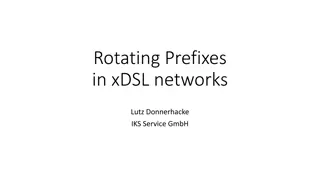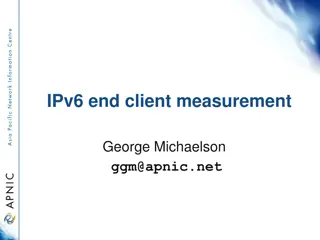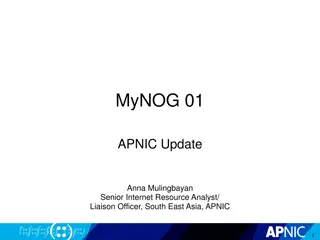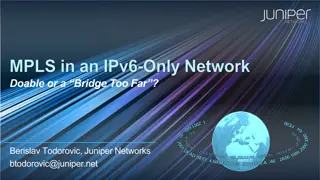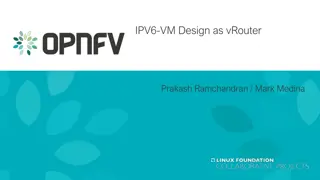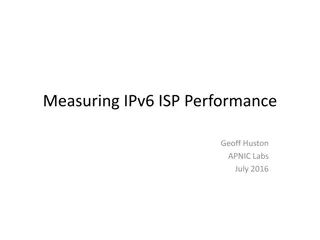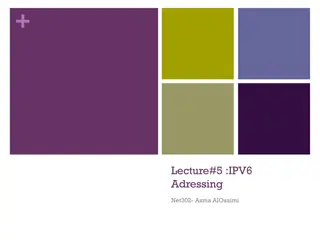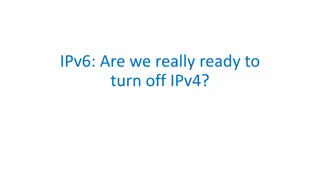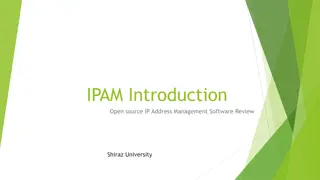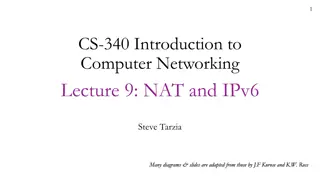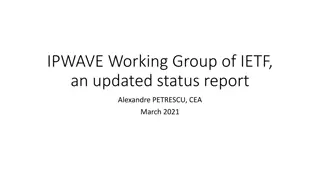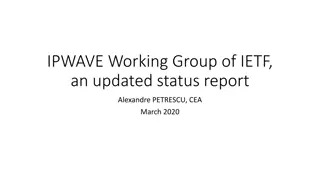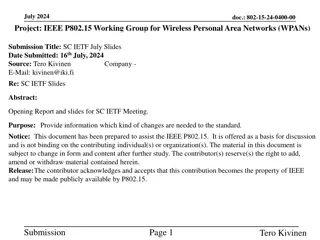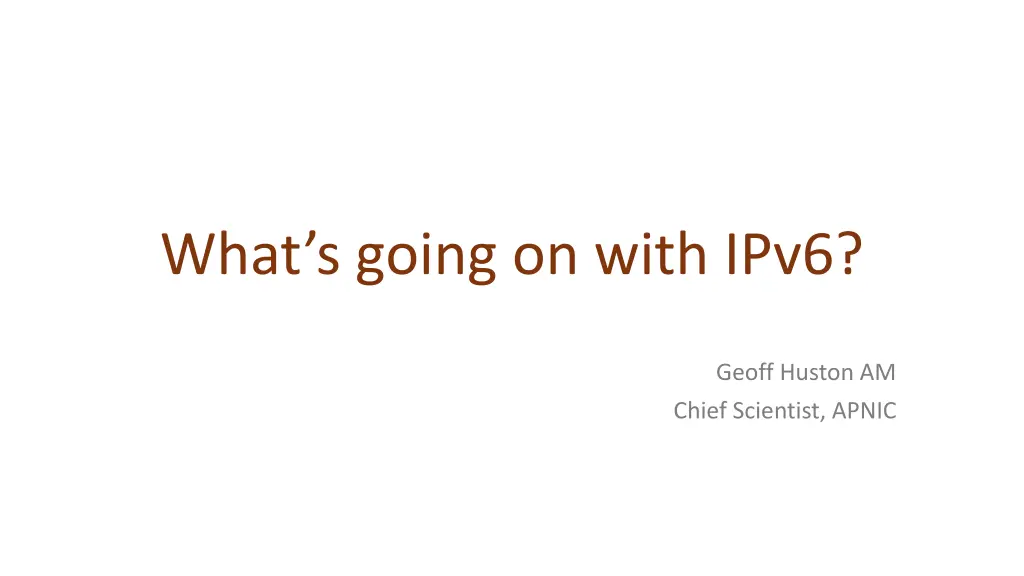
IPv6 Adoption Trends and Challenges Revealed by Geoff Huston at APNIC
Understand the current state of IPv6 adoption as presented by Geoff Huston, the Chief Scientist at APNIC. Discover why the transition to IPv6 has taken longer than expected and the varying pressures faced by different networks. Explore the potential persistence of IPv4 and what success may look like in the future.
Download Presentation

Please find below an Image/Link to download the presentation.
The content on the website is provided AS IS for your information and personal use only. It may not be sold, licensed, or shared on other websites without obtaining consent from the author. If you encounter any issues during the download, it is possible that the publisher has removed the file from their server.
You are allowed to download the files provided on this website for personal or commercial use, subject to the condition that they are used lawfully. All files are the property of their respective owners.
The content on the website is provided AS IS for your information and personal use only. It may not be sold, licensed, or shared on other websites without obtaining consent from the author.
E N D
Presentation Transcript
Whats going on with IPv6? Geoff Huston AM Chief Scientist, APNIC
IPv6 Today 0% 80% Per-Economy IPv6 Deployment Measurement - % of Users with IPv6
Projecting IPv6 Adoption % of the Internet s User Base with IPv6 We are here IPv6 Adoption over the past decade 2045! ! Year
This is unexpected Back in the early nineties when the Internet was just picking up momentum NOBODY could conceive that a transition to IPv6 would take longer than five years - tops! A total timeframe to complete this transition from start to finish of fifty years was unthinkable! But that is where we are Why?
Not everyone is feeling the pressure to adopt IPv6 Is this now a steady state? % of Users 2020 2022 2024 https://stats.labs.apnic.net/ipv6/XQ
Networks are different from each other Small to medium scale networks with low growth probably feel little pressure to introduce IPv6 dual stack Existing customer requirements are being met with IPv4 Low growth means little pressure to increase the address pools beyond current levels Any expenditure to introduce dual stack becomes a cost without any increased revenue to offset this cost
Networks are different from each other Large scale networks with continued growth will see this differently The way to alleviate the IPv4 scarcity pressure is to use Dual Stack and rely on end client preference to prefer to use IPv6 (Happy Eyeballs) And place pressure on service provider platforms to adopt IPv6
What does success look like? It s likely that IPv4 will persist for many decades to come There is no significant functional difference between the two protocols Established IPv4 networks do not feel under any pressure to change to Dual Stack if their network is providing an acceptable level of service and functionality to their users And that means that a target of 100% IPv6 adoption is not likely in every economy in the near to medium term In which case do we need to revise our definition of success for IPv6 adoption? Maybe 100% adoption is just too ambitious in this timeframe Perhaps we need to rethink what success means
India Success? 77%
Finland Success? 55%
Taiwan Success? 60%
When can we declare success? Clearly, across all of Africa, much of the Middle East, Western Asia and Southern Europe, the Internet infrastructure in incapable of sustaining further growth without some effort to support integration of dual stack platforms. In these geographies IPv6 adoption still demands further attention. But in many other economies it may be that we have already achieved success in this effort, and there is little more to be gained by pushing the IPv6 adoption message in these areas.
Why has the Transition effort fragmented? We ve been used to talking about the Internet as it it was a single entity, where users and network service providers both operate within the constraints of similar pressures and opportunities This is obviously not the case these days Network service providers are feeling increased pressure to commoditize their service offerings Because the internal economy of the Internet is changing
The network economy is changing Value has moved up the protocol stack from carriage to content and service apps apps $$$ transport Internal Transport + session security $$$ network transport network media media
So, who pays for the IPv6 transition? Networks need to make the investment to switch to a dual stack mode that includes IPv6 But neither the user base nor the content distribution world really care And they are certainly not going to pay a premium to the network operator for IPv6 And in the application service world, IP addresses are not critical resource any more We ve changed the currency of networks! not the
What does this mean? We no longer operate within a strict address-based network architecture Clients no longer use a permanent unique public IP address to communicate with servers Servers no longer use a permanent unique public IP address to communicate with clients Address scarcity takes on a different dimension when you don t need public addresses to uniquely number every host and service
A Network of Names Today s public Internet is largely a service delivery network using CDNs to push content and service as close to the user as possible The multiplexing of multiple services onto underlying service platforms is an application-level function tied largely to TLS and service selection using SNI The DNS is now used to perform closest match service platform selection, supplanting the role of routing Most large CDNs run a BGP routing table with an average AS Path Length that is intended to converge to 1!
A new Internet Architecture We ve moved from end-to-end peer networks to client/server asymmetric networks We ve replaced single platform servers-plus-network to replicated servers-minus-network with CDNs Clients aren t identified with a unique public IP address clients are inside NATs are uniquely identified only in a local context Individual services aren t identified with a unique public IP address services are identified in the DNS
A new Internet Architecture We ve moved from end-to-end peer networks to client/server asymmetric networks We ve replaced single platform servers-plus-network to replicated servers-minus-network with CDNs Clients aren t identified with a unique public IP address clients are inside NATs are uniquely identified only in a local context Individual services aren t identified with a unique public IP address services are identified in the DNS
What am I saying? The slow uptake of IPv6 is not because this industry is chronically stupid or short sighted There is something else going on here In our efforts to deliver bigger, faster, cheaper services we ve moved our attention away from the IP level of the protocol stack and today the concentrated effort lies in services and applications In many economies network providers have now done what they can with IPv6, and its now about user devices and their lifecycles. There is adequate momentum to continue IPv6 deployment through coming years!

